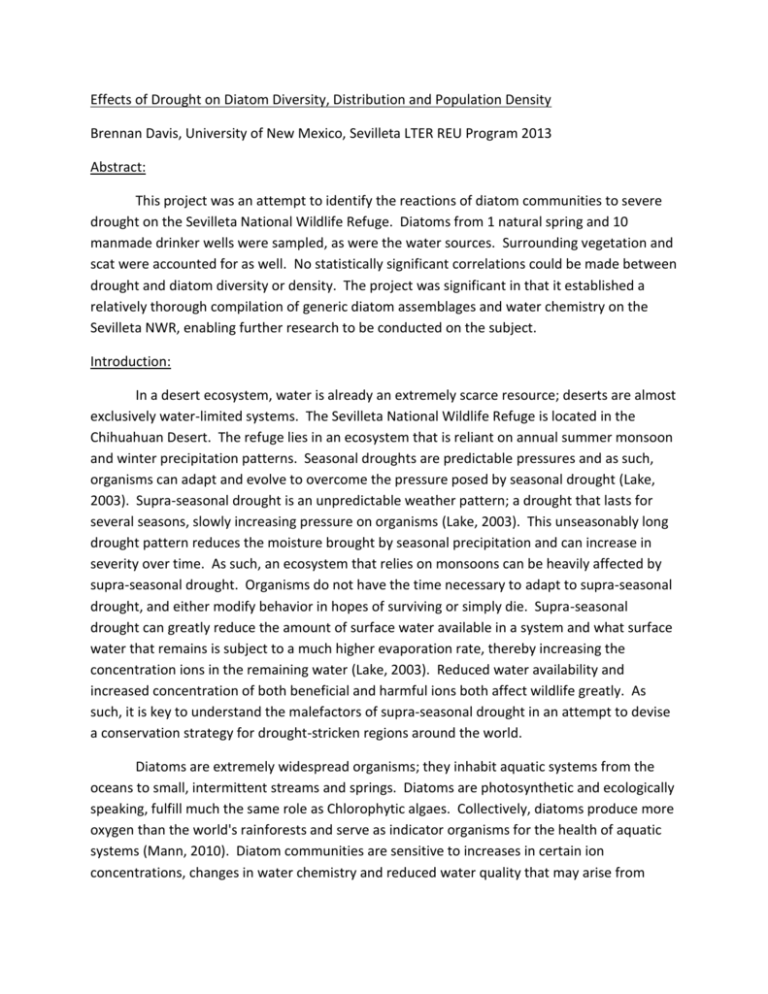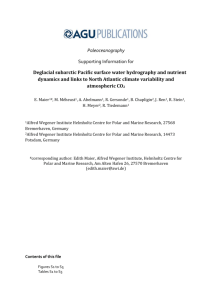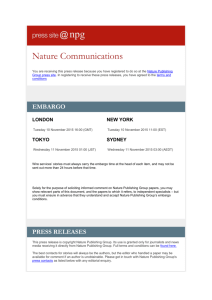BDFinalSevPaper
advertisement

Effects of Drought on Diatom Diversity, Distribution and Population Density Brennan Davis, University of New Mexico, Sevilleta LTER REU Program 2013 Abstract: This project was an attempt to identify the reactions of diatom communities to severe drought on the Sevilleta National Wildlife Refuge. Diatoms from 1 natural spring and 10 manmade drinker wells were sampled, as were the water sources. Surrounding vegetation and scat were accounted for as well. No statistically significant correlations could be made between drought and diatom diversity or density. The project was significant in that it established a relatively thorough compilation of generic diatom assemblages and water chemistry on the Sevilleta NWR, enabling further research to be conducted on the subject. Introduction: In a desert ecosystem, water is already an extremely scarce resource; deserts are almost exclusively water-limited systems. The Sevilleta National Wildlife Refuge is located in the Chihuahuan Desert. The refuge lies in an ecosystem that is reliant on annual summer monsoon and winter precipitation patterns. Seasonal droughts are predictable pressures and as such, organisms can adapt and evolve to overcome the pressure posed by seasonal drought (Lake, 2003). Supra-seasonal drought is an unpredictable weather pattern; a drought that lasts for several seasons, slowly increasing pressure on organisms (Lake, 2003). This unseasonably long drought pattern reduces the moisture brought by seasonal precipitation and can increase in severity over time. As such, an ecosystem that relies on monsoons can be heavily affected by supra-seasonal drought. Organisms do not have the time necessary to adapt to supra-seasonal drought, and either modify behavior in hopes of surviving or simply die. Supra-seasonal drought can greatly reduce the amount of surface water available in a system and what surface water that remains is subject to a much higher evaporation rate, thereby increasing the concentration ions in the remaining water (Lake, 2003). Reduced water availability and increased concentration of both beneficial and harmful ions both affect wildlife greatly. As such, it is key to understand the malefactors of supra-seasonal drought in an attempt to devise a conservation strategy for drought-stricken regions around the world. Diatoms are extremely widespread organisms; they inhabit aquatic systems from the oceans to small, intermittent streams and springs. Diatoms are photosynthetic and ecologically speaking, fulfill much the same role as Chlorophytic algaes. Collectively, diatoms produce more oxygen than the world's rainforests and serve as indicator organisms for the health of aquatic systems (Mann, 2010). Diatom communities are sensitive to increases in certain ion concentrations, changes in water chemistry and reduced water quality that may arise from unseasonable drought (Werner, 1977). As such, diatoms are prime organisms by which to study the effects of supra-seasonal drought on isolated aquatic systems in deserts. On the Sevilleta NWR, several natural springs, as well as manmade drinker wells provide water to the assorted wildlife on the refuge. The natural flowing springs on the refuge have largely become transient flowing systems and in some cases, have even dried completely. The manmade wells provide a more constant water source, though there is little to no open flow in most wells. Given that New Mexico is currently experiencing a severe supra-seasonal drought, it is necessary to determine the health of the small aquatic systems responsible for sustaining wildlife, not only on the Sevilleta NWR, but state-wide. This project was largely an attempt to classify diatom communities in natural springs and manmade wildlife drinkers on the Sevilleta National Wildlife Refuge. A study conducted in 2012 by Brianna Levinson looked at diatom diversity and distribution on the Sevilleta NWR, as well as relationships between community assemblages and water chemistry. This data is useful in that it can be used to compare diatom diversity between 2012 and 2013, however the scope of this study was expanded to include more water sources in order to provide a larger view of the diatom diversity and distribution across most of the refuge. Water chemistry as well as a survey of the surrounding area at each water source will be used to contrast with diatom diversity and distribution. This helps paint a more complete picture of how both the water sources and diatoms themselves react to supra-seasonal drought. Methods: Locations: One natural spring and ten manmade drinker wells were sampled on the Sevilleta National Wildlife Refuge. It was initially anticipated that six natural springs would be sampled, however a large number of springs on the refuge were dry due to the extreme drought. Nunn well, McKensie well, Goat Draw well, Canyon well and Gibbs well were all active and sampled on the east side of the refuge. Cibola spring was dry and therefore unable to be sampled. On the west side, 222 well, Esquivel well, West Mesa well (East and South drinkers) and San Lorenzo East well were sampled. San Lorenzo West was the only natural spring sampled on the entire refuge. The Rio Salado, 4 Springs, Canyon del Ojito and San Acacia springs were all dry. Water Sampling and Diatom Analyses: Both diatom and water samples were taken from a wide variety of water sources on the Sevilleta National Wildlife Refuge. Two diatom samples of known area (I need to take that measurement) were taken from each source of water for the purposes of consistency and to collect a density of diatoms conducive to easy counting on a microscope. Dependent upon substrate, either a Loeb sampler or a core sampler were used to collect diatoms; a sandy or loose substrate necessitated a core sampler, while a firmer, flatter substrate was suited to the Loeb sampler. Three water samples were collected from each water source to ensure accuracy and consistency; a small plastic bottle was used to collect each sample. The samples were then sent to the Earth and Planetary Sciences department at the University of New Mexico to be tested for concentrations of PO4, NO3, and various heavy metal ions. At Nunn and McKensie drinkers, a Loeb sampler was used and samples were taken from both the metal sides of the drinkers, as well as from pieces of wood floating in the drinkers. This was conducted at these two sites alone because the wood had a consistent surface, making sampling easier. Similarly, two samples were taken from 222 (Tule) well using a Loeb sampler; one sample was taken from the metal side of the well, while the other was pulled from the very thin sediment at the bottom of the well. The sampling of different substrates was done do give insight into any substrate preference exhibited by diatoms in these waters. At Esquivel well, East San Lorenzo spring (a spring-fed wildlife drinker), Goat Draw well, Canyon well and Gibbs well, one sample was taken using the Loeb sampler. Conversely, a core sampler was used to take a singular sample in sources with looser substrates like West San Lorenzo spring, and the two drinkers fed by the West Mesa well. Upon returning from the field, a small amount of 5% Formalin solution was added to each sample to halt biological activity. The samples were then standardized to a volume of 20mL, and 3mL of the standardized solutions were pipetted into 15mL centrifuge tubes. 7mL of a solution of 30% H2O2 was then added to each centrifuge tube and they were placed in a flask with water, which was then set upon a hot plate to boil for 1 hour. After boiling, the samples were centrifuged for 8 minutes each. The supernatant was drained and replaced with deionized water to a level of 13mL. Centrifugation, draining and rinsing were repeated for a total of 7 times. After processing samples was completed, 1mL of each sample was pipetted onto coverslips, which were left to air-dry for 2-3 days. After drying, the slides were fixed using ZRax resin. Transects were performed on each individual slide, counting and identifying diatoms to genus level. An estimated maximum of 300 diatoms per slide were counted and for slides with particularly low diatom densities, 10 transects maximum were performed. Vegetation Measurements: In order to gain a general understanding of the surrounding area, vegetation and scat transects were performed at each water source, and the surrounding geology was noted. This offered insights into possible nutrient, metal or mineral inputs into these aquatic systems and further served to estimate the general usage of each water source. This could increase understanding of diatom preferences to nutrient or mineral inputs as well as possible reactions to high levels of water usage by wildlife. At each water source, a 1m quadrat was used at 5m intervals for a maximum of ten times in each cardinal direction. This gave a maximum of 40 quads per spring or drinker. Percent cover of terrestrial vegetation and scat was estimated and rough identification was performed; plants were subdivided into grasses, forbs, shrubs, succulents or trees. Scat was subdivided into large herbivore, small herbivore, predator or bird. Results: Total genus richness across the entirety of the Sevilleta NWR was found to have increased to 17 genera in 2013, as opposed to 12 genera in 2012. This is likely due to the fact that more sites were sampled in this study and diatom slide transects were completed to a higher resolution in this study. Every water source that was sampled in both 2012 and 2013 displayed a higher observed diversity (by measure of generic richness) in 2013 than in 2012. 18 16 Genus Richness 14 12 10 8 6 2012 2013 4 2 0 Fig. 1: Diatom diversity on the Sevilleta NWR in 2012 and 2013. There were significant changes in ion concentration of the refuge waters from 2012 to 2013. Some ions decreased in concentration, most notably in the manmade wells, which is likely due to a constant water source keeping ion concentrations from rising. However, a host of ions that previous research suggests may be beneficial to diatom function had increased from 2012 to 2013. There was an observable correlation with these ions; higher ion levels correlated to higher diatom densities. The results, however, were not statistically significant. An increase in turbidity also caused a statistically insignificant decrease in diatom density. This may be due to higher turbidity reducing the efficiency of photosynthesis, however more samples need to be taken to generate more robust data and draw more reliable conclusions. Change in [Cu] 0.02 0.018 0.016 [Cu] (mg/L) 0.014 0.012 0.01 2012 0.008 2013 0.006 0.004 0.002 0 Nunn McKensie Gibbs San Lorenzo W. Density vs. [Cu] 160000.000 140000.000 Total Cell Density 120000.000 100000.000 80000.000 60000.000 R² = 0.2468 40000.000 20000.000 0.000 0 0.005 0.01 0.015 0.02 0.025 -20000.000 [Cu] (mg/L) Fig. 2: Concentration of copper ions has increased from 2012 to 2013. Increased levels of copper correlate, however insignificantly, to higher diatom densities. Similar trends were found with Vanadium and Boron. Percent cover of scat had no effect on diatom density, indicating that perhaps there was an insignificant input of nutrients from scat, or that high wildlife usage did not disturb diatom communities is a significant way. More samples would confirm or reject these hypotheses. As the percentage of vegetation at each water source increased, a statistically insignificant decrease in diatom density was observed. This is perhaps due to increased shade impeding photosynthesis, but further study again is necessary to determine this. Conclusion: An overall increase in generic richness from 2012 to 2013 was unexpected, though it was likely due to differences in experimental method; previous study on the subject was done at fewer sites and at a lower resolution. Reexamination of diatom slides from 2012 would be beneficial and may perhaps lend to more significant results. An increase in the concentration of some ions was expected, as this is a known consequence of drought. Further water testing in following years may give insight into how ion concentration and drought are interrelated. No statistically significant results were found during this study, largely due to small sample sizes and very limited amounts of previous data. Observable correlations were made between increased presence of certain ions and increased diatom density, and further examination could possibly yield statistically significant results. Future study on the subject will provide an opportunity to examine temporal trends in diatom resistance to drought effects, something crucial given the advance of anthropogenic global warming. With limited data to draw on due to few previous studies on the subject, this project is aimed at building a base of knowledge of diatom community assemblages during supra-seasonal drought. The information can be built upon in the future in order to classify any trends in diatom reaction to extreme drought. Works Cited: Lake, P.S. 2003. Ecological effects of perturbation by drought in flowing waters. Freshwater Biology. 48, 1161-1172. Mann, D.G. 2010. Diatoms. The Tree of Life Web Project. http://tolweb.org/Diatoms/21810. Werner, D. ed. 1977. The Biology of Diatoms. University of California Press. Berkeley and Los Angeles, California.







